|
Talgo & AVE
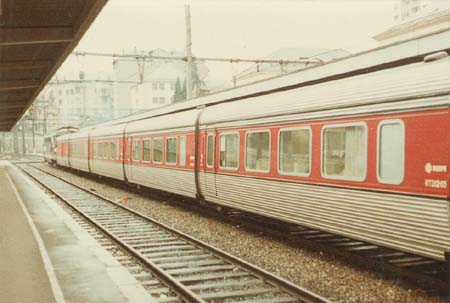
Catalan-Talgo Geneva - Barcelona, Talgo III and French diesel, Chambery, April 1984 (Ernst Wolf)
|
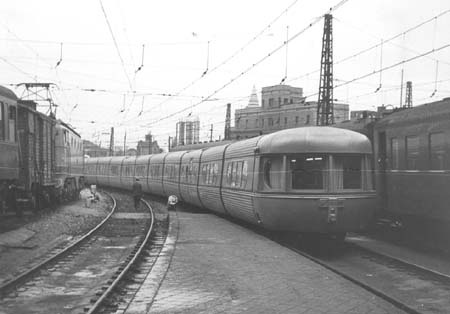
Talgo Barcelona - Madrid, Talgo II, departure Barcelona 1969 (WS)
|
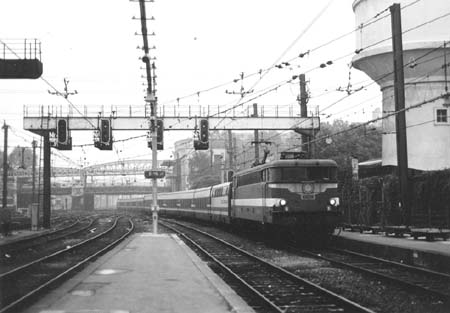 Talgo Madrid - Paris, SNCF BB-9322 and Talgo RD Camas, Paris Austerlitz, August 1984 (WS)
Talgo Madrid - Paris, SNCF BB-9322 and Talgo RD Camas, Paris Austerlitz, August 1984 (WS)
Talgo means "Tren Articulado Ligera Goicoechea Oriol", an articulated light-weight train with low gravity center, consisting of short single-axle units. Already in 1902 French engineer Sprague had that idea. Alejandro Goicoechea undertook first experiments in Spain and in 1942 the prototype (Talgo I) was built at Valladolid, supported by entrepreneur de Garay and banker Oriol. As cooperation with Germany had been prevented by WWII, four trains Talgo II were built in the United States by ACF. The Train X stayed in the USA and three ones, consisting of a diesel locomotive and 11 cars, entered service in Spain - Europe's most futuristic special-fare daylight express. Talgo III, capable of running in both directions, and Talgo Pendular with passive tilting technology followed. They provided the only up-to-date international services with sleepers, diners and bar, but their aesthetics then had been spoiled by using ordinary diesel and electric locomotives.
The Talgo III RD day train reached Geneva in 1969 (later classified as a TEE) and already in 1968 it was presented at Paris. French railway authorities however were reluctant against that foreign prestige train and on a timetable conference really there had been the proposal to combine the Madrid - Paris with a regional service. Finally Talgo Pendular night trains with sleepers, even en-suite toilets, a good restaurant service and a bar-lounge brought American streamliner atmosphere to Old Europe…They appeared in Paris, Lisbon, Zurich and temporarily Milan. Even Germany, the USA (Pacific Northwest corridor) and Kazakhstan introduced Talgo trains. A proposed Spanish night Talgo to Frankfurt however was rejected in 2003 by German railways. Portuguese CP on the contrary showed strong interest in a sleeping-car Talgo Lisbon - Irun jointly with RENFE, to be extended to Paris. May be a Talgo “Sud-Express” Lisbon – Paris could be a dream, or even the private proposal of a sleeper train Lisbon – London?
Talgo series:
Talgo II of 1950, diesel locomotives 1T to 4T (then called 350), first service Madrid - Hendaye from 1950, in service until 1972, silver.
Talgo III, of 1964, diesel locomotive classes 352 and 353 (using German V200 technology); Talgo III RD of 1968 with adjustable wheelsets for change of gauge, diesel 353, running to Lisbon and to Geneva. That Catalan Talgo changed in 1970 to SNCF class 67000 diesels, in 1982 to SNCF electrics class CC6500 and then to BB electrics. Talgo III Camas RD of 1974, all-sleeper Barcelona - Paris, change of locomotive at borders, in France electric BB9200, diesel BB67000 until electrification reached Port Bou in 1982.
Colors: Talgo III silver/red
Talgo IV, V, VI, VII
Talgo Pendular of 1980, RD with adjustable wheel sets 1981, RD Camas from 1981 all-sleeper Madrid - Paris, change of locomotive at borders, in France BB9300, then CC6500 and BB7200. In 1995 French SNCF participated in Talgo services. RD Camas were introduced Barcelona - Paris and on other routes, colors dark grey/cream, then white/blue. Talgo 200RD of 1989 is built for 200 km/h. Talgo VII opened services Barcelona - Sevilla using the high-speed line, with change of gauge and locomotives series 252 at Lleida, from 2006 Talgo 250 (S121) direct.
Colors: White/blue, new ones white.
Formations:
Talgo Madrid - Paris
Madrid Chamartin - Paris Austerlitz, by RENFE, arrival Paris, August 13, 1984:
| BB 9301 (BoBo dc Alsthom) SNCF. Hendaye - Paris |
| 1 RT 512 | | (generator van) |
| 5 RT 504 | Turistica | (sleeper) |
| 2 RT 503 | Preferente | (sleeper) |
| 1 RT 510 | Restaurante | |
| 1 RT 506 | Bar | |
| 2 RT 503 | Preferente | (sleeper) |
| 1 RT 505 | | (sleeper) |
Traction on arrival at Madrid: Diesel class 354.
Colors: Renfe Talgo and locomotive dark-grey/cream, SNCF BB light turquoise, later Talgo cream/blue.
From 1996 extended with 26 cars.
Motorcar transport by freight trains.
Talgo Lusitania-Express
Madrid Chamartin - Lisbon Sta. Apolonia, by RENFE, arrival Lisbon, Oct. 31, 2002:
| 382608 (BoBo ac Alsthom) CP, Valencia de A. - Lisbon |
| 1 | TB4z | (reclining chairs) |
| 1 | TB4 | (reclining chairs) |
| 1 | TA4 | (reclining chairs) |
| 1 | TC4 | (kitchen) |
| 1 | TR4 | Restaurante |
| 3 | TWL4 | Preferente (sleeper) |
| 3 | TWL4 | Turistica (sleeper) |
| 1 | TG4 | (generator van) |
Traction in Spain: Diesel class 333
Colors: Renfe Talgo cream/blue, CP electric orange, RENFE 333 blue/yellow.
Talgo IV, V, VI, VII and further developments
Talgo Pendular of 1980, RD with adjustable wheel sets 1981, RD Camas from 1981 all-sleeper Madrid - Paris, change of locomotive at borders, in France BB9300, then CC6500 and BB7200. In 1995 French SNCF participated in Talgo services. RD Camas were introduced Barcelona - Paris and on other routes, colors dark grey/cream, then white/blue. Talgo 200RD of 1989 is built for 200 km/h. Talgo VII opened services Barcelona - Sevilla using the high-speed line, with change of gauge and locomotives series 252 at Lleida, from 2006 Talgo 250 (S121) direct. From 2007 Madrid – Valladolid – Gijon is served by the duck-nosed S130, a derivative of Talgo 250, with change of gauge.
Colors: White/blue, new ones white.
Not all the innovative trains in Spain are necessarily Talgo or AVE trains. The gauge-changing “Alvia” units were introduced on Barcelona – Madrid services, departing from the historic Barcelona Franca terminal.
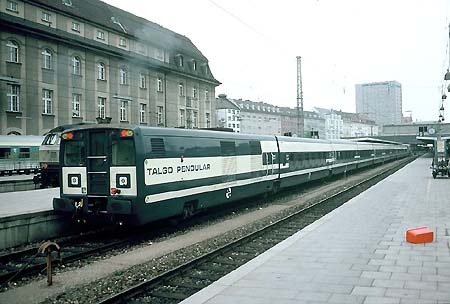
RENFE Talgo RD Camas, exclusively Gran Clase and diner, exceptionally DZ18837 Berlin Lichtenberg - Munich, at Munich Starnberger Bahnhof, May 4, 1993 (WS)
|
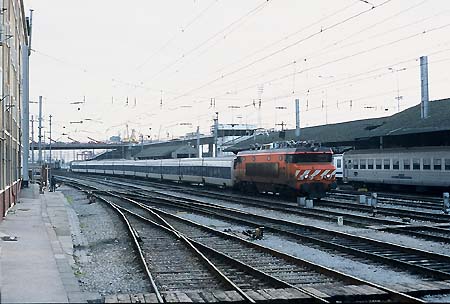
Talgo Lusitania-Express Madrid - Lisbon, Alsthom BB of CP, Lisbon 2002 (WS)
|
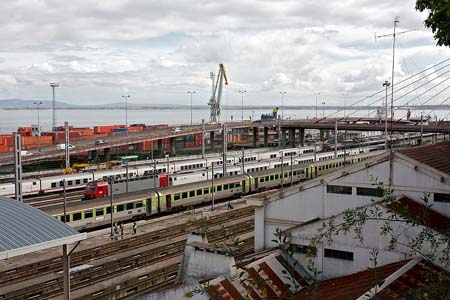
Sud Expresso Lisbon – Hendaye, Talgo set, CP engine class 5600, Lisbon 2011 (Nuno Morao, via Wikimedia)
|
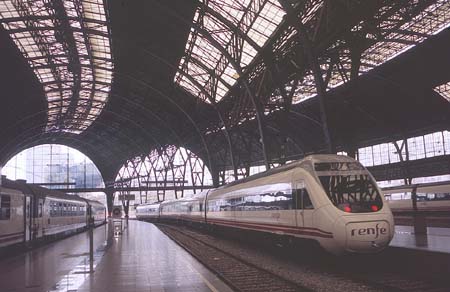
„Alvia“ Barcelona – Madrid, Barcelona Franca 2008 (WS)
|
AVE
The first new high-speed line in Spain, standard gauge, no longer broad gauge, was inaugurated in 1992 between Madrid, Cordoba and Sevilla. The AVE high-speed trains S101 were built in France, a TGV derivative for speeds of 250, later 300km/h and a traveling time of 2 hours and 20 minutes for 471km (the terrorists' massacre at Madrid Atocha station in 2005 did not hit AVE, but later the Daily Telegraph informed that the gang "tried to blow up a high-speed passenger train. Several key members of the cell blew themselves up when they were cornered by police a month later"). Slower "Euromed" TGV type trains S101.1 were introduced on broad gauge Barcelona - Valencia - Alacant (Alicante).
The high-speed AVE line Madrid - Zaragoza - Lleida (Lerida), opened in October 2003, reached Barcelona in 2008 and is being extended to Perpignan, 50 percent financed by the EU. Completion of the French LGV Mediterrannee around 2015 to 2020 should make possible to travel from Geneva to Barcelona in less than 5 hours. Talgo technology was upgraded for 330 km/h by development of the S102 or Talgo 350, nicknamed "el pato" (the ant) and, unlike the older Talgos, no longer locomotive-hauled. It offers the comfort of reversible seats. In 2005 it entered service Madrid - Lleida. The AVE S103 or Velaro E, resembling the German ICE3, was built to cover in future the 650km Madrid - Barcelona in 2 1/2 hours, equipped with the advanced European Train Control System ETCS2 and ERTMS for speeds up to 350km/h! With distributed power it omits the heavy engine units on both ends.
For regional high-speed services such as Madrid - Puertollano or Cordoba - Sevilla the non-tilting S104 was developed by Alstom/CAF from the "Alaris" pendolinos. A slightly slower series 120 has adjustable wheel sets and allows change of gauge e.g. at Lleida. In Portugal the semi-high speed "Alfa Pendular" tilting trains had been introduced on the lines Lisbon - Porto - Braga and Lisbon - Faro.
The next new AVE lines connect Madrid with Toledo and Cordoba with Malaga. For the new AVE Madrid - Valladolid an extension to Bilbao and San Sebastian is envisaged for 2015 - 2020. Madrid - Paris however would require 7 ½ hours traveling time. A standard gauge high-speed line Madrid - Badajos - Lisbon is expected around 2013 and Lisbon - Porto two years later. A high-speed Sud-Express Paris - Lisbon could be at least a dream... At least the AVE Madrid – Marseille and Barcelona – Lyon were reported (in 2015) continuing service.
AVE high-speed train series
Standard gauge, 25kV50Hz ac
| Series | Year | Services | Notes | Speed (km/h) |
| 100/101 | 1992 | Madrid - Sevilla | TGV derivative, ac/dc | 250/300 |
| 102 | 2005 | Madrid - Lleida, later Barcelona | Talgo 350 | 330 |
| 103 | 2007 | Madrid - Barcelona | ICE3 derivative | 350 |
For the AVE-2015 gauge-convertible trainset the roll-out is envisioned for 2010 or 2011.
Formations
AVE series 101
L + 8T + L, articulated 8 cars, also 2 trains coupled:
Engine unit
Car 1 Club
Cars 2-3 Preferente
Car 4 Cafeteria
Cars 5-8 Turista
Engine unit
AVE series 102
L + 12T + L, articulated Talgo 350, also 2 trains coupled:
Engine unit, 2 Club, 3 Preferente,
1 Cafeteria, 6 Turista, engine unit
AVE series 103 "Velaro E"
Distributed power M + T + M + T + T + M + T + M, also 2 trains coupled:
Car 1 Club
Cars 2-3 Preferente
Car 4 Cafeteria
Cars 5-8 Turista
L = locomotive-like BoBo engine unit, M = car with powered axles, T = trailer.
AVE colors: white, blue stripe.
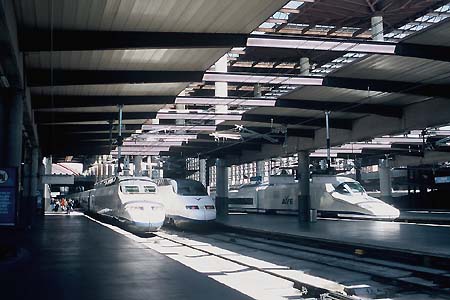
AVE series 101 and (on the right) AVE series 102 Madrid - Sevilla, Madrid Atocha, April 9, 2005 (WS)
|
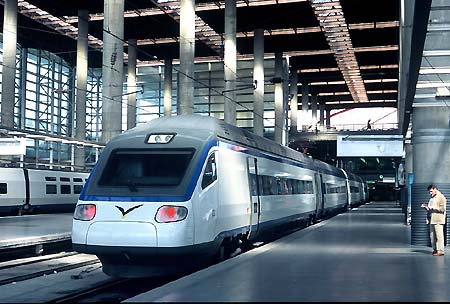
Series 104 at Madrid Atocha, April 2005 (WS)
|
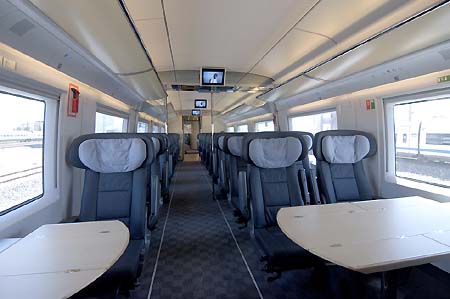
AVE series 103 Velaro E, 1st class interior (Siemens)
|
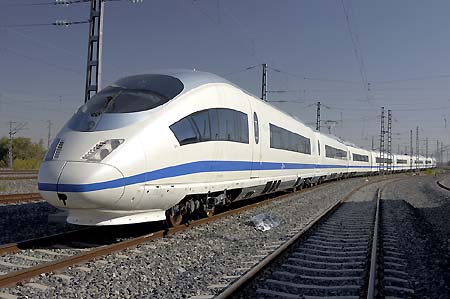
AVE series 103 VelaroE, test at La Sagra in 2005 (Siemens)
|
|